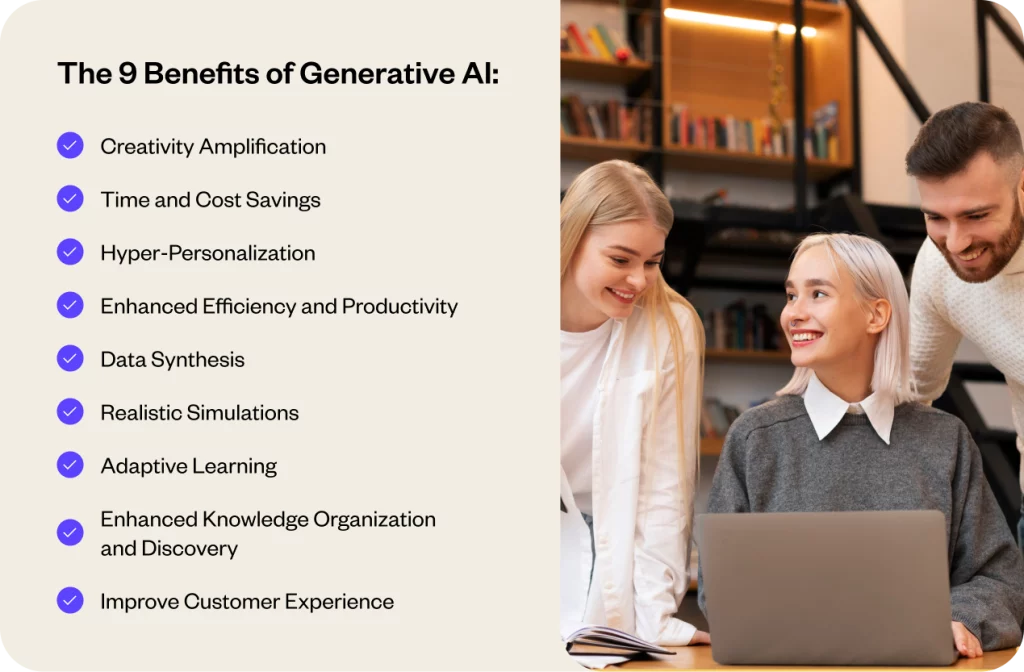In a rush and need the TL/DR version?
Summarize
Generative AI reshapes business landscapes by creating new content through advanced machine learning. It offers significant benefits, from increasing productivity to enhancing customer interaction. Below are nine key advantages of generative AI for businesses:
Key benefits
- Creativity amplification: Generates diverse and engaging content autonomously.
- Time and cost savings: Automates processes, reducing the need for manual input and cutting costs.
- Hyper-personalization: Tailors customer experiences by analyzing individual data to personalize interactions.
- Enhanced efficiency and productivity: Optimizes business workflows, improving overall efficiency.
- Data synthesis: Analyzes and synthesizes large datasets to generate actionable insights.
- Realistic simulations: Provides accurate simulations for safer and more effective product testing.
- Adaptive learning: Continuously improves its outputs based on new data and feedback.
- Knowledge organization: Mines and categorizes information for easier access and discovery.
- Improved customer experience: Delivers more human-like, responsive customer service through AI.
Generative AI boosts efficiency and creativity and personalizes and enhances customer interactions, offering a significant competitive edge. Read the full blog for an in-depth exploration of these benefits and how platforms like Yellow.ai leverage generative AI.
Note: This summary is not a substitute for reading the article in full, as you may miss out on important nuances.
Interested in learning about the benefits of generative AI – a buzzword that has swiftly entered the vocabulary of executives and boards across the globe?
In this article, we will explore how generative AI can completely transform industries, improve productivity and enhance overall business operations. From creative output and time savings to personalization and increased customer satisfaction, generative AI offers a wide range of advantages to enterprises.
We will also discuss the impact of combining generative AI with conversational AI on customer experience. Read on to discover the potential of generative AI and how it can enhance your business.
Introduction to Generative AI
Generative AI is a branch of artificial intelligence that focuses on creating new content, designs, or ideas through machine learning algorithms. Unlike traditional AI systems that rely on predefined rules, it uses vast amounts of data to generate original and innovative outputs. By analyzing patterns and learning from existing examples, generative AI models can create realistic images, music, text, and more.
Related must-reads:
- Generative AI – The ultimate guide for 2023
- How does Generative AI work: Exploring the mechanics of AI
- Top Generative AI examples – A guide for every business
- Top 10 Generative AI tools: Boosting creativity and productivity
From ChatGPT, Google Bard, and Bing Chat to Midjourney, GitHub Co-Pilot, and Dall-E 2, the world is flush with examples of what generative AI is bringing to the table. In fact, the versatility of generative AI in bridging different forms of media, such as transforming text into images or audio into text, has unlocked a vast array of creative and lucrative opportunities. Undoubtedly, as businesses and industries increasingly incorporate this technology into their research and operational processes, a plethora of new applications will continue to surface. For instance, how we at Yellow.ai are using specialized Large Language Models (LLMs) within the domain of Generative AI as robust intelligence layers to deliver solutions for complex end-user-facing use-cases that require real-time decision-making.
Yellow.ai’s Dynamic Conversation Designer – a generative Al tool – allows you to design and launch conversations in minutes – no coding required! Try for free
Now, let us delve deeper into the benefits offered by generative AI.
9 Benefits of Generative AI for business

1. Creativity amplification
Generative AI enables businesses to generate creative and engaging content on a large scale. For example, in the advertising industry, AI-powered systems can automatically generate compelling ad copy, visuals, and even video content, serving as a valuable tool for innovative ideas and reducing the need for extensive manual creative work.
“When we think about the future of the internet, I would guess that 90% of content will no longer be generated by humans. It will be generated by bots,” says Latanya Sweeney, Professor of the Practice of Government and Technology at the Harvard Kennedy School and in the Harvard Faculty of Arts and Sciences.
2. Time and cost savings
By automating tasks that previously required human intervention, generative AI saves valuable time and reduces operational costs. For instance, in architecture and design, AI algorithms can generate building designs based on given specifications, significantly speeding up the design process. Not only that, but by analyzing stakeholder feedback and market trends, it can help generate new product concepts and designs. The speed with which it can analyze massive amounts of data and make design recommendations is an immense source of its power.
3. Hyper-personalization
Generative AI can be used to hyper-personalize the customer experience by analyzing customer data and generating customized product recommendations, and offers based on individual preferences. Moreover, when it comes to customer support via voice automation, it can enable e-commerce brands to provide customer support in dynamically changing personalized voices that will take the frustration out of the support experience and make experiences more human-like and natural in comparison to stale, similar-sounding robotic voices.
Read more on – Voicebot: The complete guide to voicebots solution
4. Enhanced efficiency and productivity
With generative AI, businesses can automate complex and time-consuming processes, enabling them to optimize workflows, improve efficiency, and allocate resources effectively. For instance, in the manufacturing industry, AI algorithms can generate optimized production schedules, minimizing waste and maximizing efficiency. Not only that, in contact centers, generative AI can enable customer support agents with ticket summarizations, response and tone suggestions that best suit the context of the customer’s query, greatly increasing their productivity.
5. Data synthesis
Generative AI presents a compelling use case in the domain of data synthesis. By leveraging its ability to analyze diverse datasets, AI models can synthesize large amounts of data and generate valuable insights. For instance, in the financial sector, generative AI can analyze market trends, consumer behavior, and economic indicators to generate predictive models that enable businesses to make well-informed investment decisions. By harnessing the power of data synthesis, generative AI empowers organizations across various sectors to unlock actionable intelligence and gain a competitive edge in today’s data-driven landscape.
6. Realistic simulations
Generative AI enables the creation of realistic simulations that can be used in various fields such as training, entertainment, and research. For example, in the automotive industry, AI-powered simulators can accurately simulate driving scenarios, allowing for safer and more efficient testing of autonomous vehicles.
7. Adaptive learning
Generative AI systems can continuously learn and adapt based on feedback and new data. This capability allows the models to improve their performance over time and generate outputs that align better with user preferences and objectives. For instance, in personalized education, generative AI models can dynamically adjust learning materials and methods to match individual student needs, preferences, and learning styles, enhancing the effectiveness of educational experiences.
8. Enhanced knowledge organization and discovery
Generative AI can facilitate knowledge discovery by mining and extracting insights from diverse sources. Furthermore, it can automatically organize and categorize vast amounts of knowledge assets. By leveraging machine learning techniques, these systems can identify and tag information based on topics, themes, and relationships, facilitating easier access and retrieval.
9. Improve customer experience
Enhancing the customer experience emerges as a prominent and early business application for generative AI. Adopting dynamic AI agents that provide more human-like responses to customer inquiries allows businesses to improve customer interaction.
The underlying language models enable these chatbots to deliver more comprehensive and sophisticated responses, elevating the depth of customer interactions. Moreover, generative AI powered dynamic AI agents can play a supportive role in customer service as agent-assistants. They leverage natural language processing (NLP) to listen to agent-customer conversations and access relevant resources to enhance the interaction.
Generative AI vs conversational AI: The impact on customer experience
Generative AI and conversational AI are two interrelated yet distinct fields that have a significant impact on the customer experience. Let’s get into a detailed comparison between the two:
| Generative AI | Conversational AI | |
| Objective | Primarily focuses on content creation and generating novel and creative outputs. | Primarily facilitating natural language conversations between humans and AI systems. |
| Inputs & outputs | Accepts input data, whether structured or unstructured, and generates novel content using learned patterns. | Receives input from users in natural language and delivers relevant and contextually aware replies. |
| Training & learning | Trained on a variety of data formats, including text, photos, and audio, to discover patterns and generate content. | Large datasets containing human conversations, user queries, and responses are used to train the model. |
| Applications & use-case | Applied to virtual reality, gaming, art and design, music composition, content creation, product design, image and video enhancement. | Used in customer support, virtual assistants, chatbots, language translation, and voice interfaces. |
| Interactivity levels | Typically operates with limited interactivity, as it generates content autonomously based on patterns and examples from the training data | Offers high interactivity, capable of engaging in dynamic, real-time conversations with users, responding to questions, providing assistance, and adapting its responses based on user input. |
| Complexity | Can produce intricate and creative outputs, but may lack understanding of context and user preferences. | Can understand and respond to complex user queries, making it suitable for practical applications like customer support. |
Both Generative AI and Conversational AI complement each other in shaping the customer experience landscape. By incorporating Generative AI models into chatbots and virtual assistants, businesses can offer more human-like and intelligent interactions. Conversational AI systems powered by Generative AI can understand and respond to natural language, provide personalized recommendations, and engage in memorable conversations.
This combination empowers organizations to build stronger relationships with customers, drive loyalty, and gain a competitive edge in today’s dynamic marketplace.
Read more on: Conversational AI – A complete guide for [2023]
Yellow.ai Dynamic Automation Platform (DAP) with Generative AI capabilities is a stellar example of this synergy enabling businesses to transform the way they interact with their customers and employees. Our advanced Generative AI technology enables dynamic, goal-oriented, and human-like conversations, ensuring customers receive an unparalleled support experience.
Bringing the best of both worlds, Yellow.ai DAP with Generative AI uses multiple LLMs and proprietary insights to help businesses achieve highly personalized customer experiences.
Generative AI – FAQ
What is Generative AI, and how does it differ from traditional AI?
Generative AI is a branch of artificial intelligence that focuses on creating new and original content, such as images, music, or text, based on patterns and examples learned from training data. It differs from traditional AI by its ability to generate novel outputs instead of solely analyzing and interpreting existing data. Generative AI goes beyond traditional AI’s predictive and analytical capabilities, unlocking new possibilities for creativity, content generation, and simulation.
In what industries can Generative AI be particularly beneficial?
Generative AI has transformative potential in several industries. In the creative arts, it empowers artists, designers, and musicians to unlock new realms of creativity by generating unique and inspiring content. In healthcare, it revolutionizes drug discovery, medical imaging, and personalized treatment plans, leading to improved patient outcomes. Additionally, in gaming and entertainment, generative AI enhances virtual worlds, character creation, and interactive storytelling, delivering immersive and engaging experiences to audiences. Across these industries and beyond, the application of generative AI has the potential to significantly enhance customer experiences by providing hyper-personalized, innovative, and intuitive solutions.
Can Generative AI help in generating realistic images and content?
Yes, Generative AI is capable of generating realistic images and content. Techniques such as Generative Adversarial Networks (GANs) and Variational Autoencoders (VAEs) have been developed to generate highly realistic images that resemble real-world objects, landscapes, or even human faces. These models learn from large datasets and can generate novel images that possess intricate details, textures, and visual coherence. Similarly, Generative AI can also generate realistic content in other forms such as text, music, or video, providing a wide range of creative possibilities.
How does generative AI contribute to improving decision-making processes?
Generative AI enhances decision-making processes by providing valuable insights, augmenting data analysis, and enabling scenario simulations. By generating diverse and realistic options, generative AI helps decision-makers explore alternative strategies, assess potential outcomes, and make informed choices. This technology facilitates proactive decision-making, reduces uncertainty, and empowers organizations to navigate complex scenarios with greater confidence and agility.
What are the primary advantages of using Generative AI in content creation?
Generative AI is revolutionizing content creation by optimizing every process step, from initial research to final edits, providing speed and consistency. Here’s a detailed look at its multifaceted advantages:
- Comprehensive content production: AI facilitates the generation of a wide array of content types, including text, images, videos, and music, enabling creators to produce rich and varied media.
- Streamlined process: The content creation journey with AI begins with automated research, utilizing natural language processing to gather and synthesize information quickly. This initial step ensures that content is based on up-to-date and comprehensive data.
- Creative imagination: AI tools assist in brainstorming and suggesting ideas and themes that might take time to become evident to human creators. AI can propose fresh and relevant concepts by analyzing existing content and data trends.
- Drafting and editing: AI enhances writing efficiency by helping draft initial content versions and refining them through successive iterations. Tools like GPT (Generative Pre-trained Transformer) can generate entire articles, which creators can then edit to ensure voice and style consistency.
- Quality assurance: Beyond drafting, AI assists in editing and proofreading, checking for grammatical errors, ensuring stylistic consistency, and verifying factual accuracy, thus maintaining high-quality standards.
- Customization and personalization: AI excels in personalizing content to fit different audience segments by analyzing user engagement and feedback. This capability enables dynamic content adjustment, ensuring it resonates with various demographics.
Generative AI significantly reduces the manual effort involved in content creation, allowing creators to focus more on strategy and less on the mechanics of content production.
The bottom line
Generative AI holds tremendous potential for businesses across industries. From enhancing creativity and efficiency to improving customer satisfaction and innovation, the benefits of Generative AI are vast. By leveraging the power of Generative AI, businesses can stand out in today’s data-driven and rapidly evolving landscape.
To experience the advantages of Generative AI for your business, consider exploring Yellow.ai’s Generative AI-powered platform and request a demo today.
Stay ahead of the curve



















